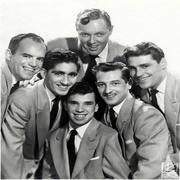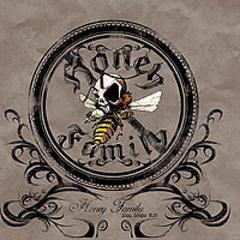Bill Haley
第一位白人摇滚巨星Bill和他的乐队为电影《The Blackboard Jungle》所创作的《Rock Around the clock》获得巨大成功,导致无数青年涌向影院,随着音乐,跳起新创的舞步,直接宣告摇滚时代的到来。 Bill Haley is the neglected hero of early rock & roll. Elvis Presley and Buddy Holly are ensconced in the heavens, transformed into veritable constellations in the rock music firmament, their music respected by writers and scholars as well as the record-buying public, virtually every note of music they ever recorded theoretically eligible for release. And among the living rock & roll pioneers, Chuck Berry is given his due in the music marketplace and by the history books, and Bo Diddley is acknowledged appropriately in the latter, even if his music doesnt sell the way it should. Yet Bill Haley — who was there before any of them, playing rock & roll before it even had a name, and selling it in sufficient quantities out of a small Pennsylvania label to attract attention from the major labels before Presley was even recording in Memphis — is barely represented by more than a dozen of his early singles, and recognized by the average listener for exactly two songs among the hundreds that he recorded; and hes often treated as little more than a glorified footnote, an anomaly that came and went very quickly, in most histories of the music. The truth is, Bill Haley came along a lot earlier than most people realize and the histories usually acknowledge, and he went on making good music for years longer than is usually recognized. The central event in Haleys career was the single Rock Around the Clock topping the charts for eight weeks in the spring and summer of 1955, an event that most music historians identify as the dawn of the rock & roll era. Getting the song there, however, took more than a year, a period in which the band had already done unique and essential service in the cause of bringing rock & roll into the world, with the million-selling single Shake, Rattle and Roll to their credit; equally important, in the three years before that, Haley and his band had already broken new ground with the singles of Rocket 88, Rock the Joint, and Crazy, Man, Crazy. Born in Highland Park, MI, in 1925, Haley was blind in one eye from birth, and, as a consequence, suffered from terrible shyness as a boy. The family moved to Boothwyn, PA, during the mid-30s, where Haley developed a strong love for country music and began playing guitar and singing; by 14, he had left school in the hope of pursuing a career in music. He bounced through a few country bands based in the Middle Atlantic states and also tried to establish himself as a singing and yodeling cowboy. His first big break came in 1944, when he replaced Kenny Roberts — who was being drafted — in the Downhomers, with whom Haley made his first appearance on records. Haley left the group in 1946 and went through several other bands before returning to his home in Chester, PA, where he initially hoped to get some work as a DJ. Instead, he formed a new band, the Four Aces of Western Swing, with keyboardman Johnny Grande, bassist Al Rex, and steel guitar player Billy Williamson, and signed a contract with Cowboy Records, a new label formed by James Myers, a composer, musician, and publisher, and his partner, Jack Howard. Their first record was released in 1948, a version of Candy Kisses; by 1949, the group had changed its name to the Saddlemen and began moving between labels, including liaisons with the fledgling Atlantic Records, Ivin Ballens Gotham Records, and Ed Wilsons Keystone Records, before finally settling at Holiday Records, a small label owned by David Miller, in 1951. Their first release, done at Millers insistence, was a cover of Rocket 88, a song that originated out of Sam Phillips fledgling recording operation in Memphis, courtesy of Jackie Brenston. It was a pumping piece of sexually suggestive, rollicking R&B, and Haley and the Saddlemen simply put a broader, slightly loping country boogie sound onto it and boosted the rhythm section, while a lead guitar (probably played by Danny Cedrone) noodled some blues licks on the break. Haley hadnt liked the idea of doing the song, but Miller wanted it, and the result — though no one knew it at the time — was the first white-band cover of what is now regarded by many scholars as the first real rock & roll song. Just to put this in perspective, rock & roll is usually written about as a phenomenon (and a reaction to) the complacency of the Eisenhower era. But Haley had released what amounted to a rock & roll single in 1951, when Ike wasnt even yet running to be president, the country was still mired in Korea, and John Kennedy not yet even a senator. Howlin Wolf was still based in Memphis and cutting sides for Sam Phillips, while a 15-year-old Elvis Presley was in tenth grade. The members of the Beatles and the Rolling Stones were still in grammar school; Lonnie Donegan was still known as Anthony Donegan and thinking of becoming an entertainer; and Alexis Korner and Cyril Davies had not yet even met. And Big Bill Broonzy was about to introduce American blues to England. At the time, Rocket 88 didnt seem to matter too much in terms of sales, as it was neither fish nor fowl; not good enough R&B to eclipse Brenstons original among black record buyers, nor sufficiently a country record the way white audiences or the radio stations that catered to them wanted. No one even had a name for what it was; a race record as the trades called discs done in a style that seemed aimed at black listeners, but one done by a white band in a kind of country style. Indeed, the band itself remained strangely anonymous; Miller had seen to it that there were no publicity photos of Bill Haley & the Saddlemen, a calculated effort to obscure their race, though the bands name and the country ballad B-sides to those early singles pretty much told who they really were. That debut single sold just a few thousand copies regionally, as did its follow-up, Green Tree Boogie. Meanwhile, when Haley and his band played, they and their business manager, Jim Ferguson, began to notice that it was the younger audience members who responded best to the R&B-style songs that Miller had them doing. They also saw all around them that enthusiasm for country music was flat, and that if they were looking for a hit, it likely wasnt going to come from this new direction. They were trying all kinds of permutations of country and R&B and getting some response, but they didnt know what it exactly was that they were doing musically. Then came Rock the Joint, their first release on Millers new Essex Records label; it had a beat, it had a memorable catch phrase, and it had a great performance at its core (including the very same solo that Danny Cedrone would later use on Rock Around the Clock), and it sold well enough that the band had to go on tour promoting it. One of the places where it sold well was Cleveland, where DJ Alan Freed picked up on the song; it was immediately after this that Freed began referring to the music embodied by Rock the Joint, music that he played every night on his show, as rock & roll, thus giving Haley a good deal of justification for his later claim to have been in on the birth of the music before anyone ever knew it. [Note: Marshall Lyttle remembers Rock the Joint as the song Freed was playing during an appearance by the band on his radio show, when he began using the phrase rock & roll — scholars who agree with the Haley connection also often attribute Freeds inspiration to the later single Crazy, Man, Crazy, while other historians say that Freed appropriated the phrase from Wild Bill Moores Were Gonna Rock, Were Gonna Roll.]By this time, the bandmembers, all well into their 30s and long past being teenagers, were taking what amounted to a crash course in what that audience wanted; at Fergusons suggestion, they played hundreds of high-school dances, not normally a venue that a professional country band would bother with. In the process, they also changed their image and name. By 1952, Bill Haley and the Saddlemen were history; instead, playing off of their leaders name and the celestial phenomenon called Halleys Comet, they became Bill Haley & His Comets. The cowboy hats and other country paraphernalia were junked as well. And they took a close look at the successful R&B stage acts of the time, especially the Treniers, and began working out wild quasi-acrobatic moves by their bass player and saxman, in particular, stuff that was unthinkable for a country band but seemingly what the kids devoured at dances. Most important, they would try out material, phrases, and stage moves, seeing what worked and what didnt, in front of the teenage audiences they found in Pennsylvania; and they listened to the way that this teenaged audience talked. Haley tried to use phrases that he heard, and put them into this musical stew; some of what they came up with was pleasantly silly material like Dance With a Dolly and Stop Beatin Round the Mulberry Bush (though even the latter had a guitar solo worth hearing more than once). But some of it, like Rockin Chair on the Moon, was years ahead of its time; and some of it, like Crazy, Man, Crazy — a Haley original whose title came from a piece of teen slang that hed heard — did exactly what was intended, hitting the Top 20 on the pop charts in 1953, a first for a white band playing an R&B-style song. Late that year, James Myers offered Haley and Miller a song that he had published (and, on paper, at least, co-authored as Jimmy De Knight) entitled Rock Around the Clock. Written almost as a parody of R&B conventions, its principal composer was Max C. Freedman, a songwriter best remembered up to that time for his 1946 hit Sioux City Sue, and also responsible for such songs as Do You Believe in Dreams and Her Beaus Were Only Rainbows. Miller either genuinely didnt see the potential of the song, or else he didnt like the business arrangement that Myers had with Haley, because he refused to record it. After a few more attempts at cutting other songs for the teen market that simply didnt work, Haley and the band and their manager were ready to leave Miller and Essex Records. A meeting was set up with Milt Gabler, a producer at Decca Records, who not only liked the song and had no problem cutting it, but saw some serious potential in Bill Haley & His Comets, based on what Essex had done with them on Rock the Joint and Crazy, Man, Crazy. A contract was signed, and on April 12, 1954, the band, with Danny Cedrone on lead guitar, did a two-song session in New York that yielded Thirteen Women — a post-nuclear holocaust sex fantasy worthy of Hugh Hefner (who had only started up Playboy magazine a year earlier) — and Rock Around the Clock. It was released a month later and made the charts for one week at number 23, selling 75,000 copies, not bad but not very significant either. It was enough, however, for Gabler to schedule another session in early June, where the band recorded Shake, Rattle and Roll. That was the record that broke the band nationally on Decca, reaching number seven and selling over a million copies between late 1954 and early 1955. They followed it up quickly with Dim, Dim the Lights (I Want Some Atmosphere), a jaunty piece that reached number 11 nationally and actually made the R&B charts for Haley, a first for him. Then, in early 1955, James Myers managed to get Rock Around the Clock placed in the juvenile delinquency drama The Blackboard Jungle, playing over the credits. The movie was a huge hit, and in its wake Decca re-released the song that spring. Rock Around the Clock shot up the charts this time, and the result was an eight-week run in the number-one spot; by some estimates, it became the second biggest worldwide-selling single after Bing Crosbys White Christmas (oddly enough, also a Decca release), 25-million copies sold worldwide. The success of Rock Around the Clock took place while Elvis Presley had yet to chart a record nationally; at a point when Chuck Berrys very first single for Chess had barely been recorded; and when Roy Orbison and Buddy Holly werent even close to auditioning for recording contracts. One has to visualize a reality in which Bill Haley & His Comets were the only established white rock & roll band, and the only white rock & roll stars in the world. Within a year, that would all change, but it was long enough for Haley and his band to become stars, with appearances on national television and a movie deal of their own. From the end of 1954 until the end of 1956, they would place nine singles into the Top 20, one of those at number one and three more in the Top Ten. The Comets were one of the best rock & roll bands of their era, with a mostly sax-driven sound ornamented with heavy rhythm guitar from Haley, a slap-bass, and drumming with lots of rim-shots; they had the blackest sound of any white band working in 1953-1955. It wasnt always obvious then, and has been forgotten today, precisely how fluid their membership was, for all of the consistency of that sound. Haleys two original bandmates from his Four Aces days, Johnny Grande and Billy Williamson, were formal partners, joined to him at the hip legally, with fixed shares in the groups earnings; tenor saxman Joey DAmbrosio, bassist Marshall Lytle, and drummer Dick Richards, by contrast, were hired employees earning 150 dollars a week plus expenses — a respectable living for most working musicians in 1955 — when Rock Around the Clock hit the top of the charts. Ironically, Danny Cedrone, whose guitar dominated that song and the key Essex hits Rock the Joint and Crazy, Man, Crazy, died in an accident in July of 1954, and his successor, Franny Beecher, was earning 150 dollars a week when he worked with the band. In the late summer of 1955, with a number-one single to their credit and lots of work in front of them, DAmbrosio, Lytle, and Richards all demanded raises, which Haley refused to grant them. They quit that month and formed a short-lived Comets soundalike unit called the Jodimars (taken from parts of their first names), who recorded for Capitol Records. Beecher was taken into the group as a full-time member (though not a partner) and remained with them until 1961, while DAmbrosios successor, Rudy Pompilli, became a core member of the band, working with them virtually without interruption for the next 19 years, until his death in 1975. In the late spring of 1956, rock & roll changed again as Elvis Presley, who was younger, leaner, and a more fiercely sexual presence, emerged as a star; he not only made music that was as good as Haleys but he looked the role of a rock & roll star. The differences in their respective images could be summed up by examining the truest scenes in the movies that each did. Rock Around the Clock, starring Bill Haley & His Comets, was a highly fictionalized account of the band and its success, but it did capture something of the spirit of the early days of rock & roll, with some good performance clips; the comparable Elvis Presley movie was Loving You, in which the singer played a fictionalized version of himself, named Deke Rivers. In Loving You, when Deke Rivers performs in front of an audience and sets the girls screaming and swooning, his would-be manager comments, If hed gone on any longer, theyd be giving him their door keys. In Rock Around the Clock, by contrast, the single truest scene depicts a would-be promoter driving through rural Pennsylvania and chancing upon a dance where Haley and company are playing; he enters, sees hundreds of kids dancing to the bands music, and asks a woman being lifted up over the head of her partner, Hey sister, whats that exercise youre getting? She answers, exuberantly, legs in the air, Its rock & roll! Haleys music was the soundtrack to a good time, whether dancing or more private recreation; Presleys music, at least where women were concerned, was an invitation to sexual fantasy about the singer. Nobody except the three Mrs. Haleys could have had sexual fantasies about pudgy, balding, dorky-looking Bill Haley. And, yet, Haley was every bit as outrageous and daring in what he got away with in his music as the worst accusations ever leveled against Presley; even Haleys bowdlerized version of Shake, Rattle and Roll was the most overtly sexual song ever to reach the American Top Ten up to that time, and Rock Around the Clock wasnt very far behind. Though Max C. Freedman mightve meant his song differently, taken literally in the true meaning of the word rock as it was used in 1953-1954, Rock Around the Clock was a bouncing, beguiling musical account of 24 hours of sexual activity, and the precursor to such numbers as Reelin & Rockin by Chuck Berry. Haley mightve looked the part of the square trying to be cool once Presley came along, but on those two songs he was as culturally and morally subversive as the worst warnings of the anti-rock & roll zealots intimated. Haley may not have seemed a cutting-edge artist after mid-1956, but he remained a force to be reckoned with in music for another year, cutting good singles — including Razzle-Dazzle, Burn That Candle, and See You Later Alligator — and several surprisingly strong albums. He did gradually lose touch with the teenage audience, and his square persona couldnt possibly compete with the likes of Presley, Jerry Lee Lewis, and Chuck Berry, though the group always put on a good show. Additionally, overseas, where any visiting American artist was treated well, Haley was greeted like visiting royalty; he always had large and fiercely loyal audiences in England, France, and Germany, which would turn out in huge numbers to see him. By 1959, Haley was no longer placing either singles or albums anywhere near the top of the charts. His brand of rock & roll, made up of R&B crossed with country boogie and honky tonk, was passé, and a switch to instrumentals didnt solve the problem of falling sales. None of this would have been so bad, except that Haley — mostly through the horrendous job done by his business manager Jim Ferguson — had managed to squander most of what hed earned during the good years, and owed a crippling tax liability to the government as well. Contrary to the popular perception, he remained an active musician throughout the 1960s, recording for Warner Bros. and a brace of other U.S. labels, and he also found a lucrative performing and recording career in Mexico (where Haley, not Chubby Checker or Hank Ballard, started the twist craze). He pursued a music career while avoiding tax liens, and trying to keep a marriage and a collapsing publishing business together. Haley managed to pull it off, getting through the decade with some possessions still in his hands, mostly by juggling a lot of gigs in Mexico and Europe and taking lots of payments in cash. Curiously, during this period Haley himself became something of a rock & roll historian in interviews; perhaps sensitive to his own experience of being shunted aside, when he talked about the twist phenomenon, he went out of his way to credit Hank Ballard as the originator of the song, and always acknowledged his debt to Big Joe Turner for Shake, Rattle and Roll. By the late 60s, with the advent of the rock & roll revival, Haley suddenly found himself faced for the first time in a decade with major demand for his work in America. It couldnt have happened at a better time, because that same year, for the first time in more than ten years, he didnt owe anything to the government. The Internal Revenue Service had been seizing all of his royalties from Decca Records for a decade, and luckily for him, Decca (possibly thanks to Milt Gabler) had been honest in its accounting; in that time, sales of Rock Around the Clock and his other Decca hits, mostly overseas, had wiped out Haleys entire six-figure tax debt. And to top off the good news, Haley not only had a full concert schedule in front of him in the U.S.A., but major record labels interested in recording him; he ended up signing with Buddha/Kama Sutra Records for a pair of live albums. The next few years showed Haley in a triumphant comeback around the world. To top it all off, Rock Around the Clock even charted anew in the Top 40 during 1974 when it turned up as the theme music for the hit television series Happy Days during its first season. By the 1970s, however, age and the ravages of time were starting to catch up on all concerned. Saxman Rudy Pompilli, whod been with him since 1955, died in 1975, and Haley eventually retired from performing. During his final years, Haley developed severe psychological problems that left him delusional at least part of the time. By the time of his death in 1981, the process of reducing his role in the history of rock & roll had already begun, partly a result of ignorance on the part of the writers handling the histories by then, and also, to a degree, as a result of political correctness; he was white, and was perceived as having exploited R&B, and there were enough people like that in the early history who had to be written about but were easier to cast as rebels. In the years since his death, the surviving members of the Comets, including pianist Johnny Grande guitarist Franny Beecher, saxman Joey DAmbrosio, bassist Marshall Lytle, and drummer Dick Richards, all in their 70s and 80s, have continued to work together and were still able to perform to sell-out crowds in Europe during the 1990s and early 2000s, doing Haleys classic repertory. Haleys own reputation has increased somewhat, particularly in the wake of Bear Family Records release of two boxes covering his career from 1954 through 1969, and Roller Coaster Records issuing of Haleys Essex Records sides. True, there are perhaps 45 songs on those 12 CDs of material that Haley should not have bothered recording, but there are hundreds more in those same collections, some of it dazzling and all of it constituting a serious body of solid, often inspired rock & roll, interspersed here and there with some good country sides. Perhaps little of the post-1957 stuff could set the whole world on fire, but Haley had already been there and done that, and still had a lot of good music to play.


 Lets Twist Again(Remastered) - Bill Haley
Lets Twist Again(Remastered) - Bill Haley























